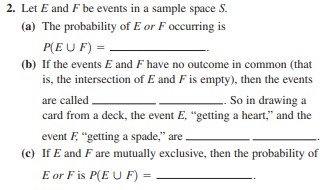2. Let E and F be events in a sample space S. (a) The probability of E or F occurring is P(E U F) = (b) If the events E and F have no outcome in common (that is, the intersection of E and F is empty), then the events So in drawing a card from a deck, the event E, "getting a heart," and the are called event F, "getting a spade," are , (c) If E and F are mutually exclusive, then the probability of E or F is P(E U F) =
2. Let E and F be events in a sample space S. (a) The probability of E or F occurring is P(E U F) = (b) If the events E and F have no outcome in common (that is, the intersection of E and F is empty), then the events So in drawing a card from a deck, the event E, "getting a heart," and the are called event F, "getting a spade," are , (c) If E and F are mutually exclusive, then the probability of E or F is P(E U F) =
Algebra and Trigonometry (MindTap Course List)
4th Edition
ISBN:9781305071742
Author:James Stewart, Lothar Redlin, Saleem Watson
Publisher:James Stewart, Lothar Redlin, Saleem Watson
Chapter14: Counting And Probability
Section14.2: Probability
Problem 2E: Let E and F be events in a sample space S. aThe probability of E or F occurring is P(EF)= _________....
Related questions
Question

Transcribed Image Text:2. Let E and F be events in a sample space S.
(a) The probability of E or F occurring is
P(E U F) =
(b) If the events E and F have no outcome in common (that
is, the intersection of E and F is empty), then the events
So in drawing a
card from a deck, the event E, "getting a heart," and the
are called
event F, "getting a spade," are ,
(c) If E and F are mutually exclusive, then the probability of
E or F is P(E U F) =
Expert Solution
This question has been solved!
Explore an expertly crafted, step-by-step solution for a thorough understanding of key concepts.
Step by step
Solved in 2 steps

Recommended textbooks for you

Algebra and Trigonometry (MindTap Course List)
Algebra
ISBN:
9781305071742
Author:
James Stewart, Lothar Redlin, Saleem Watson
Publisher:
Cengage Learning

Algebra and Trigonometry (MindTap Course List)
Algebra
ISBN:
9781305071742
Author:
James Stewart, Lothar Redlin, Saleem Watson
Publisher:
Cengage Learning